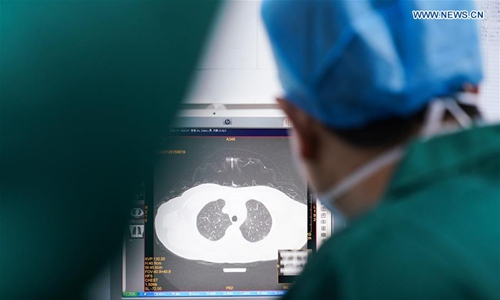Coronavirus may turn into a chronic disease

A doctor checks the CT image of a patient's lungs in Zhangzhou Municipal Hospital in Zhangzhou, southeast China's Fujian Province, Feb. 2, 2020. Zhangzhou Municipal Hospital is a designated hospital to treat patients infected with the novel coronavirus in the city. It has started receiving patients with its emergency wards since Jan. 26 in a bid to fight against the virus outbreak. (Photo by Xiao Heyong/Xinhua)
Unlike SARS, the novel coronavirus may turn into a chronic disease and exist in the world like an influenza, Chinese experts warned, saying the virus could attack multiple organs, not only lungs.
SARS is highly transmissive and pathogenic. It is difficult for such a virus that has both strong transmissibility and strong pathogenicity to survive and continue to spread from person to person and will be gone when the virus kills the host, Wang Chen, a deputy head of the Chinese Academy of Sciences, told the media on Wednesday.
"Unlike SARS, the novel coronavirus may become chronic and exist in the world for a long time like influenza," Wang warned, adding that we must be prepared through daily prevention and clinical diagnosis.
After a month of clinical treatment of coronavirus infected patients in Wuhan, Hubei Province, three experts from the central medical team said it is more difficult to treat severe cases of COVID-19 than SARS, as the virus could harm multiple organs besides the lungs.
Most patients infected with the novel coronavirus are predominantly older than 50 years of age, who mostly have underlying diseases such as cardiovascular and cerebrovascular diseases, while SARS patients are mainly young and middle-aged people, experts said. The novel coronavirus progresses very fast, which can easily lead to hypoxia and cause respiratory failure if not properly controlled.
The coronavirus can infect not only lungs but also multiple organs, such as hearts, kidneys and intestines, making the treatment of severe patients more difficult than SARS patients. SARS mainly infects lungs, according to the experts.
Experts noted that to increase the treatment of critical patients, the indicators of patients - heart rate, blood pressure and blood oxygen - should be given close attention.
Although it is more difficult to treat severe cases of coronavirus than SARS, its mortality rate is lower than SARS, which is about 10 percent.
According to an analysis by the Chinese Center for Disease Control and Prevention based on 72,314 confirmed cases of coronavirus patients, the fatality rate of the NOVID-19 is 2.3 percent, and the rate in Hubei Province, the epicenter, is 2.9 percent.
The mortality rate of patients with coronavirus will be further controlled, experts noted, as numerous medical teams are gathering in Wuhan and taking charge of ICU wards and adopting various measures.
Numbers of novel coronavirus infections reported outside the epicenter of Hubei Province declined for the 16th consecutive day as reported on Wednesday, with 45 new cases.
As of Wednesday night, Hubei Province reported 349 new cases of novel coronavirus pneumonia, with 108 new deaths and 1,209 cases of recovery. The total number of infections in the province climbed to 62,031.
Global Times